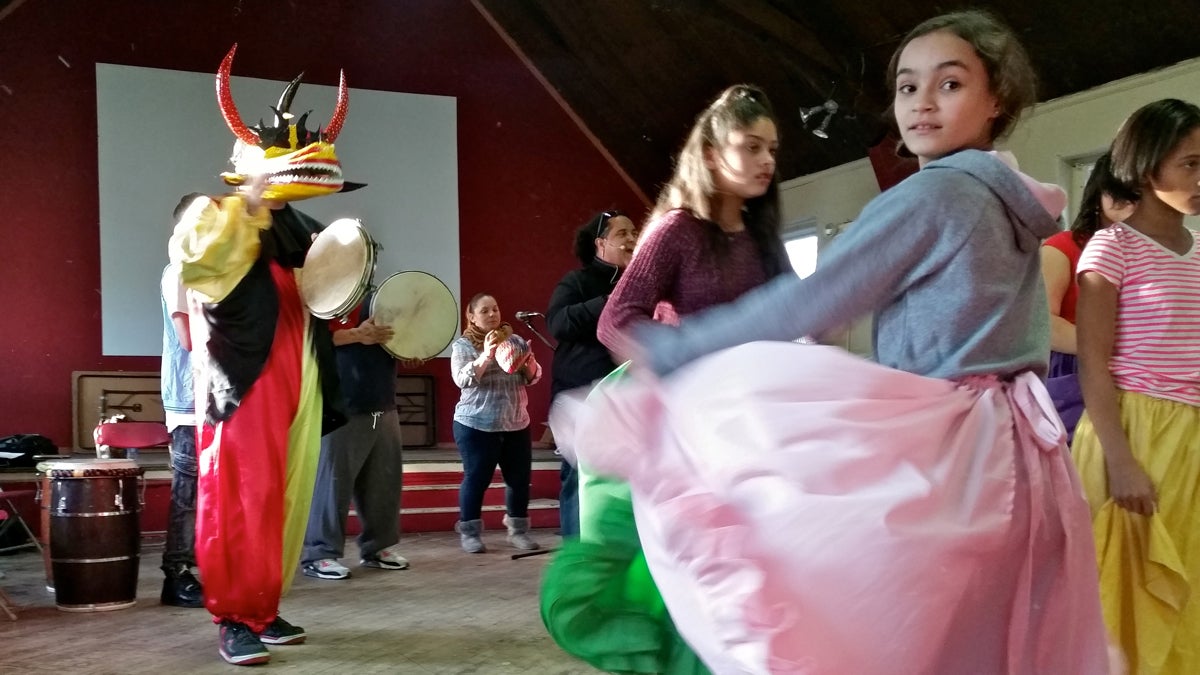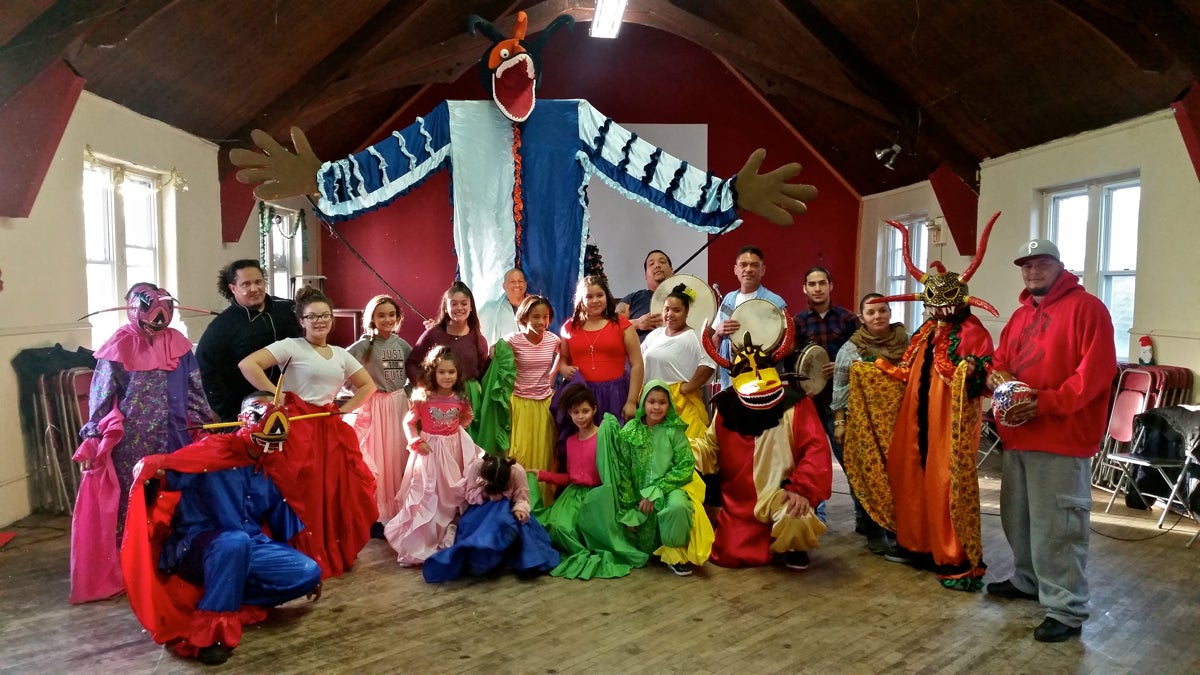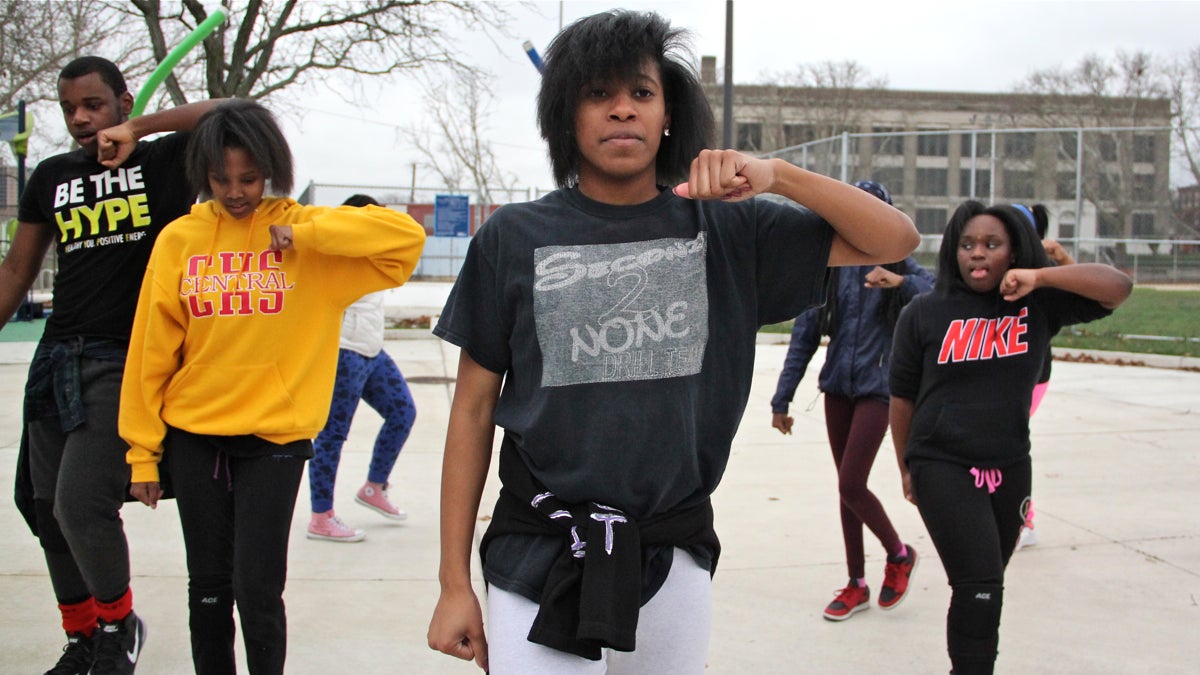Mummers hope getting more diverse will help boost crowds and ranks
Listen
Members of Los Bomberos de Calle practice their routine for the 2016 Mummers Parade. (Peter Crimmins/WHYY)
Los Bomberos de Calle, a traditional Puerto Rican performance troop based in North Philadelphia, is gathering 25 traditional folk masks for New Years Day. Each vejigantes mask is made of a halved coconut, carved with holes for eyes and mouth and brightly painted, however menacing.
Radiating out of each mask are a ring of 2-foot spikes. They are a folk method of policing derelict kids. Not your usual fare for Philadelphia’s Mummers Parade, but this year Los Bomberos will be strutting in the New Year.
“There is a story that they were used for scaring children back to their homes when they were out to late, past curfew,” said choreographer Christopher Aviles. “Vejigantes would jump out of the woods to scare these kids back home.”
Los Bomberos de Calle was formed two years ago when its founder, Anthony Mendez, noticed Puerto Rican culture in North Philadelphia was “dying out.” There are a handful of core members, including drummers, singers, and dancers performing for area schools and festivals.
 Los Bomberos de Calle will bring Puerto Rican traditions to the 2016 Mummers Parade. (Peter Crimmins/WHYY)
Los Bomberos de Calle will bring Puerto Rican traditions to the 2016 Mummers Parade. (Peter Crimmins/WHYY)
Between them they have just two or three vejigantes costumes. When the word went out about an opportunity to perform during the Mummers Parade on New Year’s Day, Puerto Ricans from across the region contributed to the cause. There will be about 25 vejigantes costumes on Broad Street, sourced as far as Allentown and Maryland.
Many Puerto Ricans — some of whom likely have never seen a Mummers parade — are expected to attend for the first time.
That’s the point. The Mummers parade has always been primarily white, working class families and neighbors who have been working together for generations. The parade has gotten somewhat insular. Attendance, both performers and spectators, has been dropping.
After last year’s parade, when some comic wenches held signs reading “Wench Lives Matter,” the city’s Human Relations Commission got involved, telling parade organizers that something has got to change.
The Mummers were only too happy to comply.
“There used to be five comic groups, now there’s three. There used to be four fancy groups, now there’s one. There used to be 27 string bands, now there’s 17,” said Leo Dignam, a deputy commissioner in the Department of Parks and Recreation, who directs the parade. “In order for this parade to survive they really have to reach out to outside groups and more diverse segments of Philadelphia.”
By word of mouth, groups around the city caught wind this new initiative, the Philadelphia Division, was looking for new performers. They were only required to be Mummer-like, with colorful costumes, music, and a performance.
“The masks are similar. They are clown-like and the characters act crazy,” said Mendez inside a North Philadelphia church community center where Los Bomberos de Calle rehearsed. “There are some similarities, but it’s a different culture with different language and percussion.”
On the other side of the city, in the Mill Creek Recreations Center in West Philadelphia, an African-American drill team has been working up its own routine for the Mummers Parade. Second 2 None, a competitive drill team that spends most of its time preparing for the next meet, is working up a Transformers space-robot routine for the Mummers parade.
 Members of the Second 2 None Drill Team practice at the Mill Creek Playground in West Philadelphia. (Emma Lee/WHYY)
Members of the Second 2 None Drill Team practice at the Mill Creek Playground in West Philadelphia. (Emma Lee/WHYY)
“The Mummers do their little strut and wave and stuff,” said Second 2 None founder Nakeia Laws. “Since we’re a drill team we have to look like a unit, with precision steps.”
Laws says she has always wanted to march with the Mummers, seeing a similarity between Fancy brigades and drill team. It’s a dream she is trying to instill in her teenage drummers and dancers, who have little or no affinity with the annual New Year’s Day parade.
“A couple of them say, ‘I always watch it on TV but I never saw it in person,” said Laws. “I tell them, ‘I’m like that, too. I never been in person.’ I always wanted to go to the Fancy — the indoor part of the parade — but I only ever saw it on TV.”
This year’s parade will be a trial run, to see how the parade can integrate as many new performers and spectators as possible. The Philadelphia Division came together at the last minute, leaving groups precious little time to get a routine together. Parade organizers are already looking at ways to streamline the recruitment process.
“It’s really up to the new groups to see if they like this parade,” said Dignam. “It’s not always easy to get up at 5 a.m. on a holiday when it’s 32 degrees outside, and get on a bus to 15th and Market. They have to decide if they like it.”
WHYY is your source for fact-based, in-depth journalism and information. As a nonprofit organization, we rely on financial support from readers like you. Please give today.





